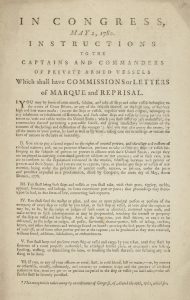 Library of Congress, Rare Book and Special Collections Division, Continental Congress & Constitutional Convention Broadsides Collection
Library of Congress, Rare Book and Special Collections Division, Continental Congress & Constitutional Convention Broadsides Collection
In attempting to prove Revolutionary War service for a man from Norwich, Connecticut, who did not show up in any militia lists, pension records, war memorials, etc., I turned to the subject of privateering. According to the DAR Genealogy Guidelines, “privateers were privately owned, armed trading vessels, commissioned or issued letters of marque from either the Continental Congress or from individual provisional government[s] (sometimes by both) to capture enemy ships and goods. The bounty or prize was divided by the officers and seamen and the governing body that authorized the privateering. Bounties made privateering very profitable and provided much needed supplies to the American forces. The Continental Congress officially authorized privateering for the war on 23 March 1776, although some states had already initiated privateering prior to that date.”
Norwich, located at the head of the Thames River, was a center for ship-building; the largest shipping firm in Norwich was Howland & Coit. Vessels traveled down the river and then sailed from New London harbor. Records and Papers of the New London County Historical Society states that 1779–81 were very active years for Connecticut privateers.
Yet, as often as British ships were captured, so were those of the privateers. According to the History of Norwich, Connecticut: From its Possession by the Indians, to the Year 1866, “Most of the adventurers from Norwich and New London were captured, imprisoned, and exchanged during the war, and some of them more than once.” One such person was a Captain John Cook, one of the several commanders of the Cromwell; the ship was taken and its crew imprisoned in one of the horrific New York prison ships, where many died. Cook escaped by going overboard and swimming to the shore. A few weeks later, however, he was on a trading voyage aboard the Turn of Times, where he was again captured and carried to Bermuda.[1]
Not all private ships were issued Letters of Marque, and therefore, the officers and crew on these particular ships were not providing military or patriotic services. In the latter years of the war, there was a “corrupt, underhand, smuggling trade.” In Norwich, in 1782, an association of sixty-eight men was formed: “Members of the Association Against Illicit Trade.” Since illicit goods were acquired and then sold for cash, the money found its way back to the British instead of aiding American forces. This association supported civil authority, shunned any social or business interactions with anyone involved in illegal trade, and set up a “neighborhood watch” in suspected places of smuggled goods. The association ended soon after the war was over.
The website American War of Independence—At Sea includes an alphabetical list of privateers, with links to detailed sourced information. In our R. Stanton Avery Special Collections at NEHGS, we have several manuscripts regarding privateering during the Revolutionary War, including Documents Concerning the Ship Protector 1779–1780; one of the documents is a Letter of Marque issued by the Major Part of the Council of Massachusetts Bay to John Foster Williams, commander of the armed ship Protector, on 8 October 1779. Another document is cosigned by Governor John Hancock. Another manuscript, Esek Hopkins letter, 1777 February 9, to Joseph Olney, is a handwritten letter in which Hopkins, Commander in Chief of Continental Navy, orders Joseph Olney to engage in privateering cruises against British store ships.
Sources:
- DAR Genealogy Guidelines, National Society Daughter of the American Revolution, Revised June 2014, 63.
- Records and Papers of the New London County Historical Society, Part IV (New London, Conn: The Society, 1893), 1: 7–26.
- Frances Manwaring Caulkins, History of Norwich, Connecticut: From its Possession by the Indians, to the Year 1866 (Chester, Conn: The Pequot Press, 1976), 387–408.
- Documents Concerning the Ship Protector 1779-1780, Mss 853, R. Stanton Avery Special Collections, New England Historic Genealogical Society.
- Esek Hopkins letter, 1777 February 9, to Joseph Olney, Mss C 5904, R. Stanton Avery Special Collections.
- Library of Congress, Rare Book and Special Collections Division, Continental Congress & Constitutional Convention Broadsides Collection http://hdl.loc.gov/loc.rbc/bdsdcc.06401.
Note
[1] Caulkins, History of Norwich, Connecticut: From its Possession by the Indians, to the Year 1866, 407.
Share this:
About Nancy Bernard
Nancy holds a certificate from the Boston University Genealogical Research program. She has a master’s degree in history and media study from SUNY University of Buffalo, where she focused on American cultural history and writing and producing documentary videos. She also has a B.A. from Hamilton College. She has interned at the American Jewish Historical Society, now at NEHGS, as well as the National Heritage Museum in Lexington, MA. Her areas of interest include New England and New York history and researching house histories and the families who lived in those homes.View all posts by Nancy Bernard →